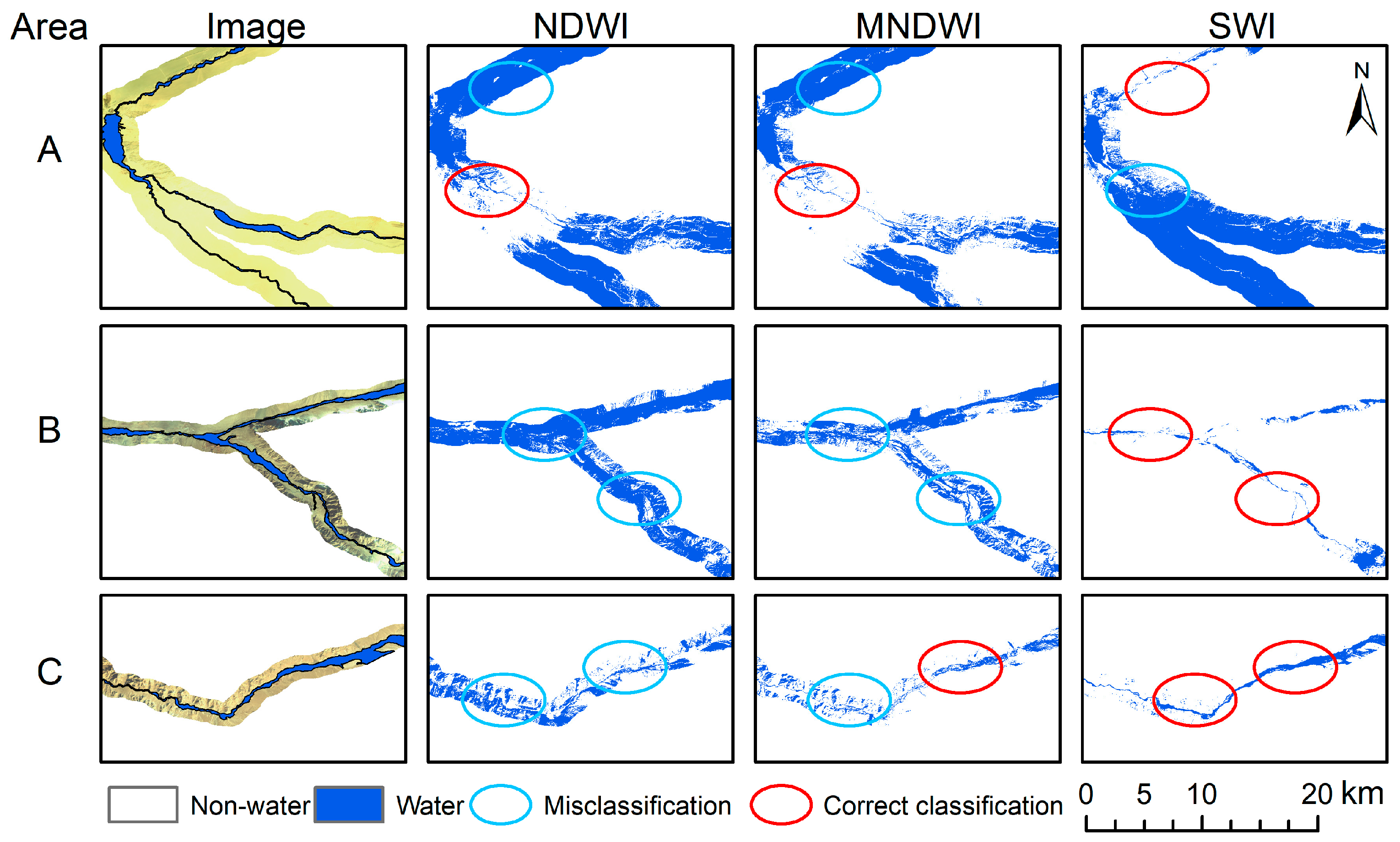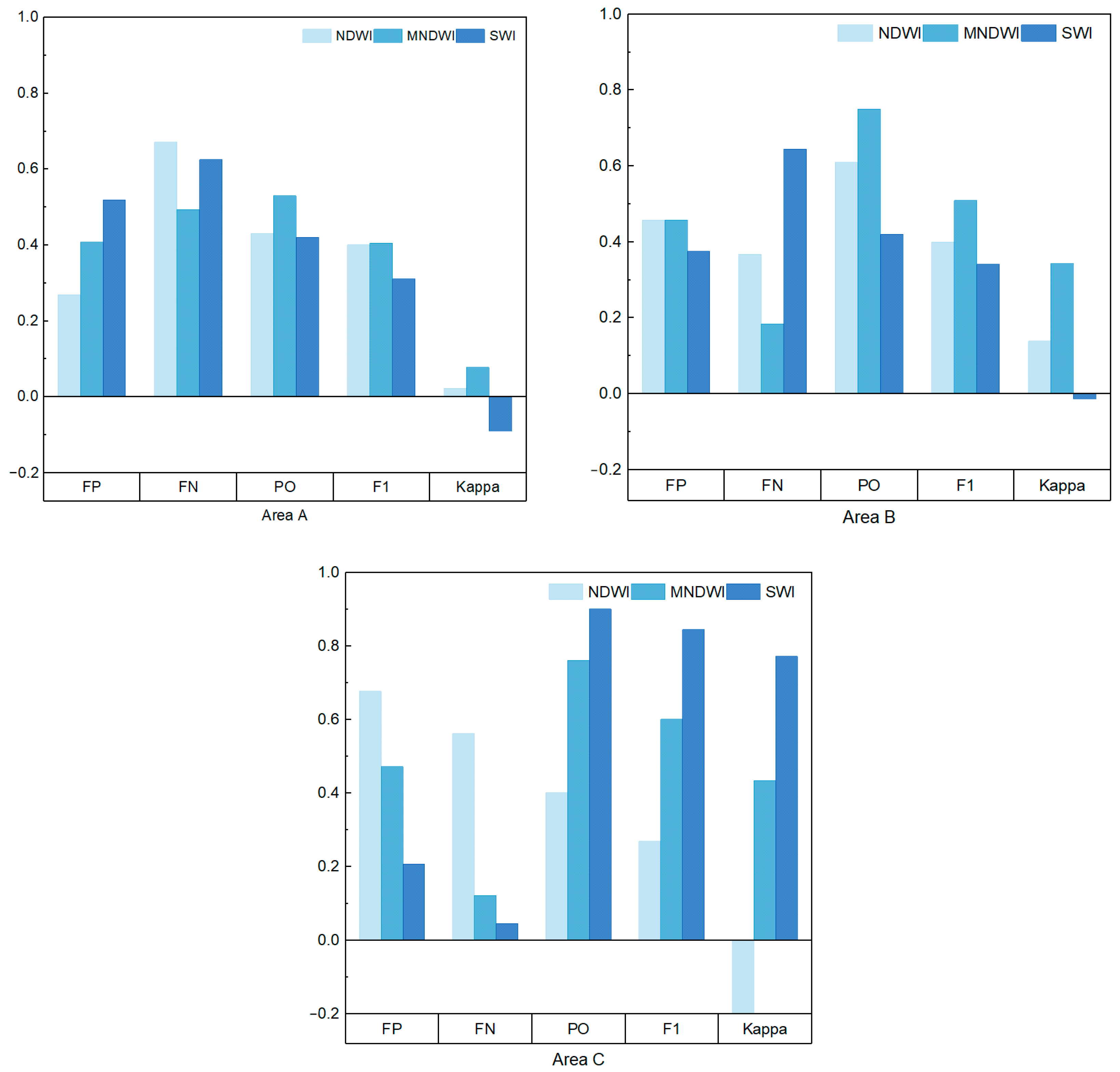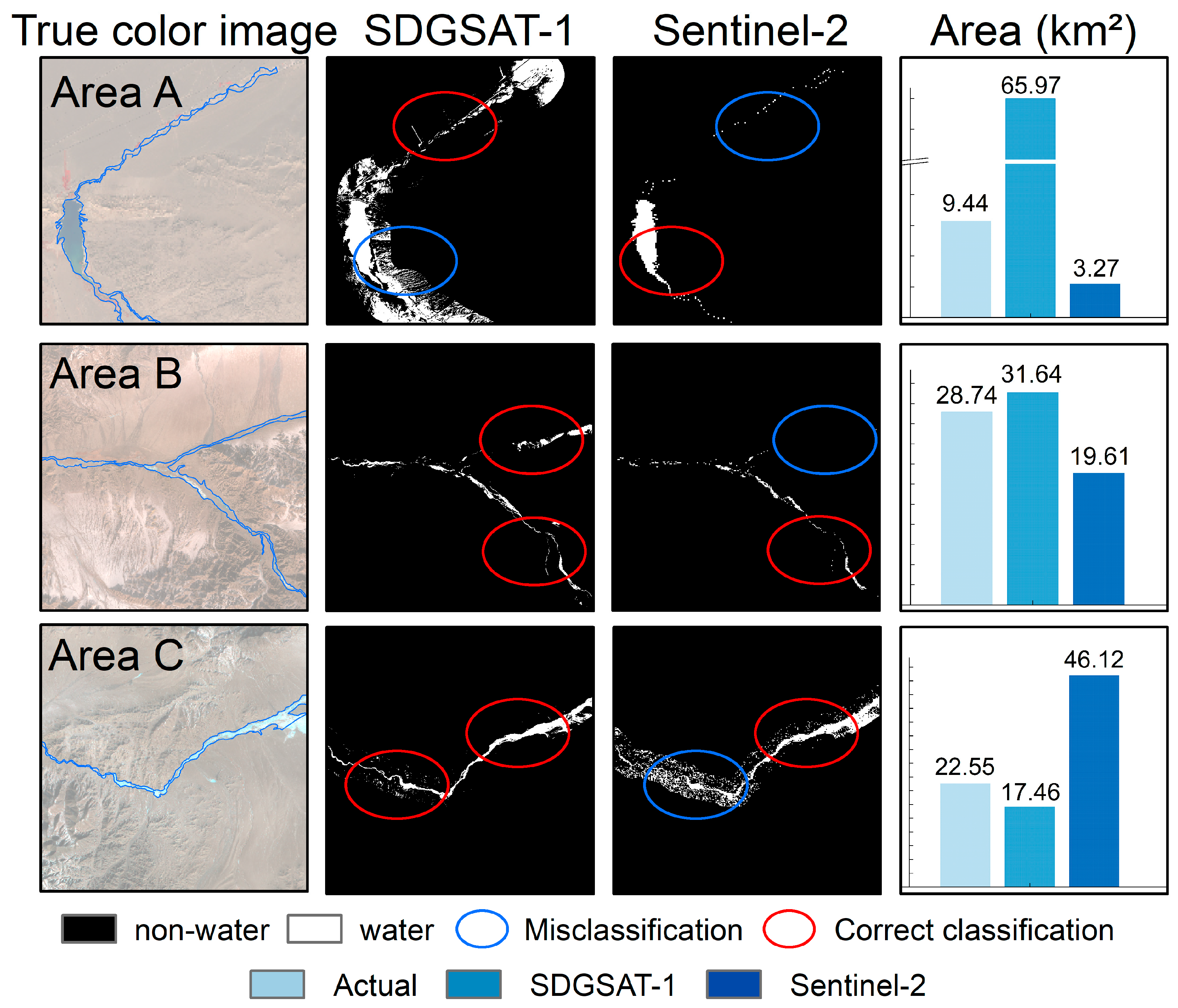Evaluating the Sustainable Development Science Satellite 1 (SDGSAT-1) Multi-Spectral Data for River Water Mapping: A Comparative Study with Sentinel-2
Abstract
:1. Introduction
2. Study Area and Materials
2.1. Study Area
2.2. Data
2.2.1. SDGSAT-1 Data
2.2.2. Sentinel-2 Data
3. Methodology
3.1. Preprocessing
3.2. River ROI
3.3. Determination of the Optimal Segmentation Threshold
3.4. Accuracy Assessment
4. Results
4.1. River Water Mapping of SDGSAT-1
4.2. Accuracy Assessment
5. Discussion
5.1. Performance Comparison of Four Threshold Methods
5.2. Performance Comparison of SDGSAT-1 and Sentinel-2
6. Conclusions
- (1)
- SDGSAT-1 and Sentinel-2 images exhibit strengths and weaknesses in extracting the Dang River. Equipped with two blue bands, the multi-spectral imager of SDGSAT-1 can accurately depict water characteristics vital to SDGSAT-1 studies. When paired with SWI, it effectively negated the influence of mountain shadows, highlighting the unique features of the Dang River. Conversely, Sentinel-2 excels in extracting water bodies within narrow areas, which is particularly evident in Area A.
- (2)
- The NDWI and MNDWI show similar accuracy in extracting the Dang River. NDWI demonstrates proficiency in delineating a broader spectrum of water bodies, whereas the MNDWI minimized shadow interference. Although the SWI’s performance in delineating water bodies on Sentinel-2 is satisfactory, the river extracted from SDGSAT-1 exhibits superior precision, with a clear outline and minimal shadow interference.
- (3)
- Different thresholding methods are tailored to specific river characteristics. In regions where rivers are prominently featured, water bodies were accurately delineated using the single threshold method and Otsu methods. For narrow river widths, the visual interpretation method was employed to advantage, while areas affected by mountain shadows were effectively managed utilizing the confidence thresholding method. The confidence thresholding method has proven effective for extracting water bodies from SDGSAT-1 data. With complex datasets such as those from Sentinel-2, it is imperative to integrate additional techniques to enhance accuracy and efficiency.
Author Contributions
Funding
Data Availability Statement
Conflicts of Interest
References
- Huang, C.; Li, Y.; Tarpanelli, A.; Wang, N.; Chen, Y. Observing river discharge from space: Challenges and opportunities. Innov. Geosci. 2024, 2, 100076. [Google Scholar] [CrossRef]
- Li, D.; Wang, G.; Qin, C.; Wu, B. River Extraction under Bankfull Discharge Conditions Based on Sentinel-2 Imagery and DEM Data. Remote Sens. 2021, 13, 2650. [Google Scholar] [CrossRef]
- Li, W.; Du, Z.; Ling, F.; Zhou, D.; Wang, H.; Gui, Y.; Sun, B.; Zhang, X. A Comparison of Land Surface Water Mapping Using the Normalized Difference Water Index from TM, ETM+ and ALI. Remote Sens. 2013, 5, 5530–5549. [Google Scholar] [CrossRef]
- Liu, S.; Wu, Y.; Zhang, G.; Lin, N.; Liu, Z. Comparing Water Indices for Landsat Data for Automated Surface Water Body Extraction under Complex Ground Background: A Case Study in Jilin Province. Remote Sens. 2023, 15, 1678. [Google Scholar] [CrossRef]
- Cui, Z.; Ma, C.; Zhang, H.; Hu, Y.; Yan, L.; Dou, C.; Li, X.-M. Vicarious Radiometric Calibration of the Multispectral Imager Onboard SDGSAT-1 over the Dunhuang Calibration Site, China. Remote Sens. 2023, 15, 2578. [Google Scholar] [CrossRef]
- Hou, Y.; Xing, Q.; Zheng, X.; Sheng, D.; Wang, F. Monitoring Suspended Sediment Concentration in the Yellow River Estuary and Its Vicinity Waters on the Basis of SDGSAT-1 Multispectral Imager. Water 2023, 15, 3522. [Google Scholar] [CrossRef]
- Sharma, R.; Tateishi, R.; Hara, K.; Nguyen, L. Developing Superfine Water Index (SWI) for Global Water Cover Mapping Using MODIS Data. Remote Sens. 2015, 7, 13807–13841. [Google Scholar] [CrossRef]
- McFeeters, S.K. The Use of the Normalized Difference Water Index (NDWI) in the Delineation of Open Water Features. Int. J. Remote Sens. 1996, 17, 1425–1432. [Google Scholar] [CrossRef]
- Chandrababu Naik, B.; Anuradha, B. Extraction of Spread Surface Water Body Using Supervised and Unsupervised Classification Techniques. Int. J. Recent Technol. Eng. 2020, 8, 2345–2350. [Google Scholar]
- Paul, A.; Tripathi, D.; Dutta, D. Application and Comparison of Advanced Supervised Classifiers in Extraction of Water Bodies from Remote Sensing Images. Sustain. Water Resour. Manag. 2018, 4, 905–919. [Google Scholar] [CrossRef]
- Huang, C.; Yun, C.; Shi, Z.; Wu, J. Detecting, Extracting, and Monitoring Surface Water From Space Using Optical Sensors: A Review. Rev. Geophys. 2018, 56, 333–360. [Google Scholar] [CrossRef]
- Xiong, L.; Deng, R.; Li, J.; Liu, X.; Qin, Y.; Liang, Y.; Liu, Y. Subpixel Surface Water Extraction (SSWE) Using Landsat 8 OLI Data. Water 2018, 10, 653. [Google Scholar] [CrossRef]
- Li, L.; Su, H.; Du, Q.; Wu, T. A Novel Surface Water Index Using Local Background Information for Long Term and Large-Scale Landsat Images. ISPRS J. Photogramm. Remote Sens. 2021, 172, 59–78. [Google Scholar] [CrossRef]
- Jiang, W.; Ni, Y.; Pang, Z.; Li, X.; Ju, H.; He, G.; Lv, J.; Yang, K.; Fu, J.; Qin, X. An Effective Water Body Extraction Method with New Water Index for Sentinel-2 Imagery. Water 2021, 13, 1647. [Google Scholar] [CrossRef]
- Xu, H. Modification of Normalised Difference Water Index (NDWI) to Enhance Open Water Features in Remotely Sensed Imagery. Int. J. Remote Sens. 2006, 27, 3025–3033. [Google Scholar] [CrossRef]
- Li, C.; Wang, S.; Bai, X.; Tan, Q.; Yang, Y.; Li, Q.; Wu, L.; Xiao, J.; Qian, Q.; Chen, F.; et al. New Automated Method for Extracting River Information Using Optimized Spectral Threshold Water Index. Arab. J. Geosci. 2019, 12, 13. [Google Scholar] [CrossRef]
- Anonymous. Transforming Our World: The 2030 Agenda for Sustainable Development. Civ. Eng. Mag. S. Afr. Inst. Civ. Eng. 2016, 24, 26–30. [Google Scholar]
- Liu, L.; Li, Q.; Niu, Z.; Huo, X. Comparative Study on Information Extraction of Urban Wetlands and Its Thermal Environment Using the SDGSAT-1 Data. Int. J. Digit. Earth 2024, 17, 2310728. [Google Scholar] [CrossRef]
- Van Der Meer, F.D.; Van Der Werff, H.M.A.; Van Ruitenbeek, F.J.A. Potential of ESA’s Sentinel-2 for Geological Applications. Remote Sens. Environ. 2014, 148, 124–133. [Google Scholar] [CrossRef]
- Drusch, M.; Del Bello, U.; Carlier, S.; Colin, O.; Fernandez, V.; Gascon, F.; Hoersch, B.; Isola, C.; Laberinti, P.; Martimort, P.; et al. Sentinel-2: ESA’s Optical High-Resolution Mission for GMES Operational Services. Remote Sens. Environ. 2012, 120, 25–36. [Google Scholar] [CrossRef]
- Cai, L.; Tang, D.; Li, C. An Investigation of Spatial Variation of Suspended Sediment Concentration Induced by a Bay Bridge Based on Landsat TM and OLI Data. Adv. Space Res. 2015, 56, 293–303. [Google Scholar] [CrossRef]
- Hai, W.; Shen, Y.; Liang, L.; Yu, Y.; Yan, Y.; Guang, L. River Extraction from Remote Sensing Images in Cold and Arid Regions Based on Attention Mechanism. Wirel. Commun. Mob. Comput. 2022, 2022, 9410381. [Google Scholar]
- Hancock, G.R. The Use of Digital Elevation Models in the Identification and Characterization of Catchments over Different Grid Scales. Hydrol. Process. 2005, 19, 1727–1749. [Google Scholar] [CrossRef]
- Liu, X.; Deng, R.; Xu, J.; Zhang, F. Coupling the Modified Linear Spectral Mixture Analysis and Pixel-Swapping Methods for Improving Subpixel Water Mapping: Application to the Pearl River Delta, China. Water 2017, 9, 658. [Google Scholar] [CrossRef]
- Ngoc, D.D.; Loisel, H.; Jamet, C.; Vantrepotte, V.; Duforêt-Gaurier, L.; Minh, C.D.; Mangin, A. Coastal and Inland Water Pixels Extraction Algorithm (WiPE) from Spectral Shape Analysis and HSV Transformation Applied to Landsat 8 OLI and Sentinel-2 MSI. Remote Sens. Environ. 2019, 223, 208–228. [Google Scholar] [CrossRef]
- Li, X.; Lyu, X.; Tong, Y.; Li, S.; Liu, D. An Object-Based River Extraction Method via Optimized Transductive Support Vector Machine for Multi-Spectral Remote-Sensing Images. IEEE Access 2019, 7, 46165–46175. [Google Scholar] [CrossRef]
- Almarines, N.R.; Hashimoto, S.; Pulhin, J.M.; Tiburan, C.L.; Magpantay, A.T.; Saito, O. Influence of Image Compositing and Multisource Data Fusion on Multitemporal Land Cover Mapping of Two Philippine Watersheds. Remote Sens. 2024, 16, 2167. [Google Scholar] [CrossRef]
- Smets, L.; Van Leekwijck, W.; Tsang, I.J.; Latré, S. Training a Hyperdimensional Computing Classifier Using a Threshold on Its Confidence. Neural Comput. 2023, 35, 2006–2023. [Google Scholar] [CrossRef]







| SDGSAT-1 MSI | Sentinel-2 MSI | ||||
|---|---|---|---|---|---|
| Description | Center Wavelength (nm) | Resolution (m) | Description | Center Wavelength (nm) | Resolution (m) |
| B1 (Deep Blue1) | 400.63 | 10 | B1 (Coastal) | 443 | 60 |
| B2 (Deep Blue2) | 438.47 | 10 | B2 (Blue) | 490 | 10 |
| B3 (Blue) | 495.10 | 10 | B3 (Green) | 560 | 10 |
| B4 (Green) | 553.23 | 10 | B4 (Red) | 665 | 10 |
| B5 (Red) | 656.75 | 10 | B5/B6/B7 (Red Edge) | 705/740/783 | 20 |
| B6 (NIR) | 776.12 | 10 | B8 (NIR) | 842 | 10 |
| B7 (SWIR) | 854.02 | 10 | B8A (Red Edge) | 865 | 20 |
| B9 (Water vapor) | 945 | 60 | |||
| B10 (SWIR-Cirrus) | 1375 | 60 | |||
| B11 (SWIR-1) | 1610 | 20 | |||
| B12 (SWIR-2) | 2190 | 20 | |||
| Name of the Features | Calculation Formulas |
|---|---|
| Normalized Differential Water Body Index [8] (NDWI) | |
| Normalized Difference Water Index [15] (MNDWI) | |
| Shaded Water Body Index [14] (SWI) |
| Image | Index | Value |
|---|---|---|
| NDWI | −0.0513 | |
| Sentinel-2 | MNDWI | 0.1576 |
| SWI | 3500.9000 | |
| NDWI | 0.2349 | |
| SDGSAT-1 | MNDWI | 0.1589 |
| SWI | 4494.3200 |
| Index | Area A | Area B | Area C |
|---|---|---|---|
| Actual (km2) | 9.4369 | 28.7418 | 22.5541 |
| NDWI (km2) | 67.7812 | 114.5599 | 51.1401 |
| MNDWI (km2) | 50.6923 | 68.4500 | 21.6155 |
| SWI (km2) | 65.9701 | 31.6403 | 17.4584 |
| Index | Area A | Area B | Area C |
|---|---|---|---|
| Actual (km2) | 9.4369 | 28.7418 | 22.5541 |
| NDWI (km2) | 3.2688 | 19.6092 | 46.1160 |
| MNDWI (km2) | 2.2536 | 33.5376 | 38.1852 |
| SWI (km2) | 1.3968 | 18.9504 | 30.1068 |
Disclaimer/Publisher’s Note: The statements, opinions and data contained in all publications are solely those of the individual author(s) and contributor(s) and not of MDPI and/or the editor(s). MDPI and/or the editor(s) disclaim responsibility for any injury to people or property resulting from any ideas, methods, instructions or products referred to in the content. |
© 2024 by the authors. Licensee MDPI, Basel, Switzerland. This article is an open access article distributed under the terms and conditions of the Creative Commons Attribution (CC BY) license (https://creativecommons.org/licenses/by/4.0/).
Share and Cite
Jiang, D.; Li, Y.; Liu, Q.; Huang, C. Evaluating the Sustainable Development Science Satellite 1 (SDGSAT-1) Multi-Spectral Data for River Water Mapping: A Comparative Study with Sentinel-2. Remote Sens. 2024, 16, 2716. https://doi.org/10.3390/rs16152716
Jiang D, Li Y, Liu Q, Huang C. Evaluating the Sustainable Development Science Satellite 1 (SDGSAT-1) Multi-Spectral Data for River Water Mapping: A Comparative Study with Sentinel-2. Remote Sensing. 2024; 16(15):2716. https://doi.org/10.3390/rs16152716
Chicago/Turabian StyleJiang, Duomandi, Yunmei Li, Qihang Liu, and Chang Huang. 2024. "Evaluating the Sustainable Development Science Satellite 1 (SDGSAT-1) Multi-Spectral Data for River Water Mapping: A Comparative Study with Sentinel-2" Remote Sensing 16, no. 15: 2716. https://doi.org/10.3390/rs16152716






